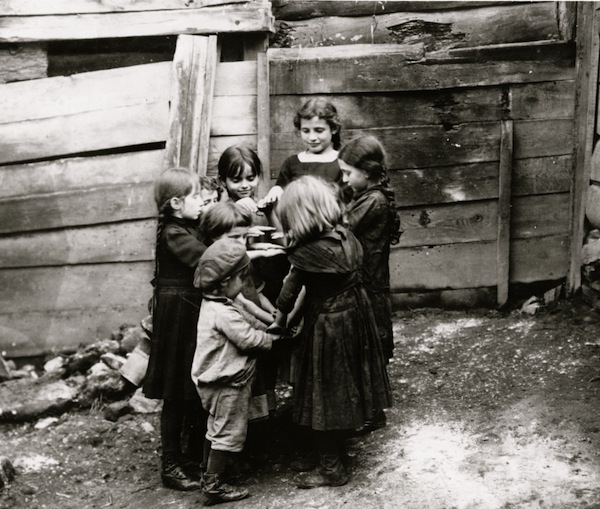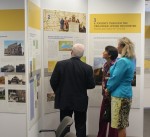Visitors at the opening of the traveling exhibition at the Schwartz/Reisman Centre in Toronto last month. (photo by Helena Yakovlev-Golani)
The exhibit A Journey Through the Ukrainian-Jewish Encounter: From Antiquity to 1914 opened last month in Toronto. It has since been held in Winnipeg (until June 27), will return to Toronto in July and then head to other cities.
The exhibit is being put on by the Ukrainian Jewish Encounter (UJE), which its website describes “as a collaborative project involving Ukrainians of Jewish and Christian heritages and others, in Ukraine and Israel, as well as in the diasporas. Its work engages scholars, civic leaders, artists, governments and the broader public in an effort to promote stronger and deeper relations between the two peoples.”
Prior to the exhibit’s opening in Winnipeg at the Oseredok Ukrainian Cultural Centre, one of its curators, Alti Rodal, an historian, writer, former professor of Jewish history, and former official and advisor to the Canadian government, spoke with the Jewish Independent.
Rodal was born in Chernivtsi (Czernowitz), Ukraine, and received her early schooling in Israel. Later, she was educated at McGill, Oxford and Hebrew universities in the fields of history and literature.
“UJE was established in 2008 by two people from Canada and the United States, both Jewish and non-Jewish Ukrainian background,” said Rodal. “It’s now a multinational organization with representatives in Ukraine, Israel, the U.S. and Canada.”
UJE’s purpose is to promote greater comprehension of the Ukrainian-Jewish relationship over the centuries, including an understanding of the co-experience of the two peoples and their interactions over the centuries, with a view to the future.
The organization has held many roundtables of scholars from Israel, Ukraine, Canada, the United States and much of Europe, each aimed at understanding a different period in history.
“To have a truthful account of the past, we’ve had a scholarly dimension unfold over the last few years in which we’ve brought together roundtable discussions among scholars of various backgrounds,” explained Rodal. “We’ve identified chunks of the history that need to be explored together and each of these roundtables addressed a different period.” The historical periods explored to date stop at the First World War.
“The exercise is one that leads to a shared historical narrative,” said Rodal. “With this we mean a single text on which the participants largely agree. If there are aspects they don’t agree on, it is stated in the single text, indicating what kind of research would be needed to advance knowledge on these issues.
“By looking to the past, we hope to obtain personal acknowledgement of what happened and to address stereotypes that both Jews and Ukrainians, at the popular level, have about each other. Some of these stereotypes are in the history books, so our aim is to produce more credible accounts and address stereotypes.”
UJE hopes that, with the help of other researchers, some of the information being taught in Ukrainian schools will be amended.
Three years ago, they entered into an agreement with the Government of Canada to do four main projects on the topic, including two publications, developing the content of their website, and the traveling exhibit, the research for which began seven years ago.
The exhibit’s first stop was in Toronto at the Schwartz/Reisman Centre and when it returns to that city, it will be to downtown’s St. Vladimir Institute, the Ukrainian cultural centre.
“These are community exhibits rather than museum exhibits, so we have them at the community centres and try to engage people from the community to participate,” said Rodal, noting that the exhibit will also go to Edmonton and Montreal.
“We’ve been approached by the Jewish community and the Ukrainian community in Ottawa and there’s been interest also from Vancouver,” she said. “We don’t have a commitment to do it, but we’ll consider it…. So, Vancouver and Ottawa are under consideration.”
The exhibit consists of text, images and video. “The first venue in Toronto consisted of 36 panels placed on moveable walls, and four videos that we created ourselves,” said Rodal. “I’m not telling you about the topics, just the physical [aspects] and the number of ethnographic maps.”

The panels go through history, from antiquity to the First World War chronologically, but there is a segment that deals with the Chassidic movement on Ukrainian lands, one on Hebrew-Yiddish printing, and another on literature and how Jews are depicted in Ukrainian writing and how Ukrainians are depicted in Jewish writing.
The videos also deal with diverse topics. One is marketplaces and taverns, where Ukrainians and Jews encounter each other, and there is a video on Jewish artisans on Ukrainian lands. Another is on ethnographic photographs, largely taken between the 1880s and 1914 on S. Ansky’s expeditions.
“Ansky was an ethnographer who led expeditions around these times, visiting many communities accompanied by a musicologist/photographer, his own nephew,” explained Rodal. “They took pictures and collected folksongs and folklore and objects, which then they put in the museum in St. Petersburg.
“When the Soviets came, it was put in the warehouse and stayed in the warehouse in the 1990s, when the St. Petersburg Historical Centre made these photographs accessible. So, a selection of these photographs of Jewish life from the 1890s to 1914, and also a collection of similar ethnographic photographs of Ukrainian life in various regions, is one of the videos.”
The videos are comprised of photographs with effects accompanied by appropriate music, including a recording made more than 100 years ago on wax cylinders.
UJE’s first objective was to explain that the presence of Jews on Ukrainian land dates back to antiquity. “It didn’t just appear in the 18th century or even the 16th century, but was there in the very first centuries or even earlier, as merchants in colonies co-founded with Greeks,” said Rodal.
“There was also lots of significant cross-cultural interaction between the Jews and the Slavic peoples in the language, folklore, music and cuisine … so that what one thinks is Jewish cuisine, you delve a little and you see the Ukrainians are eating the same things with different names.
“The vast majority of Jews lived in areas where the vast majority of Ukrainians lived. They had more interactions with Ukrainians than with other Slavic peoples…. People who’ve come to North America from what they say [is] Russia, they mean czarist Russia, these places that are coming from Galicia … and the Ukrainian lands that were part of the czarist empire … are now Ukraine.
“Another important message, which is an offshoot of the other, is that the stories of these peoples are intertwined, that we have the motto that the history of one is incomplete without the history of the other. That is the goal – to treat this historical experience in all its complexity – including the periods of crisis and violence.
“We state very clearly that not addressed in this exhibition are the horrible events of the 20th century. And we may do more about this in a different format rather than a visual exhibition. We are certainly doing it in the form of the shared narrative exercise.”
For more information about UJE, visit ukrainianjewishencounter.org.
Rebeca Kuropatwa is a Winnipeg freelance writer.

